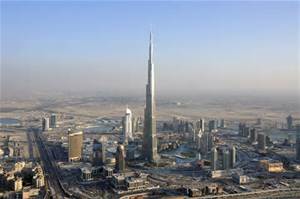This rather plaintive update from The New York Times –
A century ago, the world’s tallest building was the Woolworth Building in Lower Manhattan, at 60 stories and a height of 792 feet.
Today it’s the 163-story, 2,717-foot glass-and-steel Burj Khalifa, opened in Dubai, United Arab Emirates, on this day in 2010.
What’s next in the race to the top?
Saudi Arabia has the 1,972-foot Makkah Royal Clock Tower in Mecca, currently No. 3, but it hopes to take first place from Dubai with the Jeddah Tower, expected to rise to 3,281 feet in 2018 if it opens on schedule.
Ten more towers to pierce the clouds are either under construction or are in the planning stages, according to the Council on Tall Buildings and Urban Habitat. Not one is planned in the West.
If all the projects are realized, by 2020 the global skyline would be dominated by China, which would have nine of the 20 tallest skyscrapers.
Of those, Manhattan would have only the 1,776-foot-high 1 World Trade Center and the Central Park Tower, which is expected to be just a bit shorter when completed in 2019.
New York still has many “supertall” towers in the works. It’s just that the rest of the world has caught up and surpassed it in the last century.
This rather scary study from the Billy Graham Organization –
In your Old Testament reading, have you come across the term high places? Mentioned
117 times, high places were centers for Canaanite idol worship that the Jews were
commanded to tear down. But instead, these places became idols that subtly seduced
God’s people year after year—they couldn’t stay away!
What can we learn about overcoming recurring, seductive sin from the stories about
high places? Something mentioned 117 times is more than an archeological curiosity!
The Hebrew word for high place is bamah—mountaintop, open-air altars on elevated
knolls near towns. According to 1 Kings 14:23, the Canaanites “built for themselves
high places and sacred pillars and Asherim on every high hill and beneath every
luxuriant tree.”
Even before Israel crossed the Jordan into Canaan, Moses exhorted the Jews to
“demolish all their high places … [or they] will become as pricks in your eyes and
as thorns in your sides” (Numbers 33:52, 55).
High open aired altars were not just a sign of a spiritual deviance, so was the need to build these towers into the clouds as the Bible tells us happened at Babel. There is something about people in the East that makes them want to build these monuments to hubris.
From Genesis 11 –
11 Now the whole world had one language and a common speech. 2 As people moved eastward, they found a plain in Shinar and settled there. They said to each other, “Come, let’s make bricks and bake them thoroughly.” They used brick instead of stone, and tar for mortar. Then they said, “Come, let us build ourselves a city, with a tower that reaches to the heavens, so that we may make a name for ourselves; otherwise we will be scattered over the face of the whole earth.”
Of course we know that the Egyptians wanted to build Pyramids and they enlisted the aid of the Hebrews and the rest, as they say is history.
Elevating false Gods or elevating ourselves to be like God seems to be a particular issue of people “in the East”. Seems to be but it is a universal instinct and a sinful one. From the tower at Babel to the boss that makes sure his desk chair is taller than the visitors chair, there is the impulse to elevate ourselves.
There were also Wise Men in the East who followed a star to find a King and a God and they found Him. We have the image of them finding Him “down in a lowly stable”. The Bible says they found Him in a house. (Matthew 2). To me it makes little difference. What makes a difference is that they un – elevated themselves. The bowed down and worshipped Him. They bowed before One who un – elevated Himself. This is the one who for us men and for our salvation, “came down from heaven and was born of the virgin Mary and became man”.


